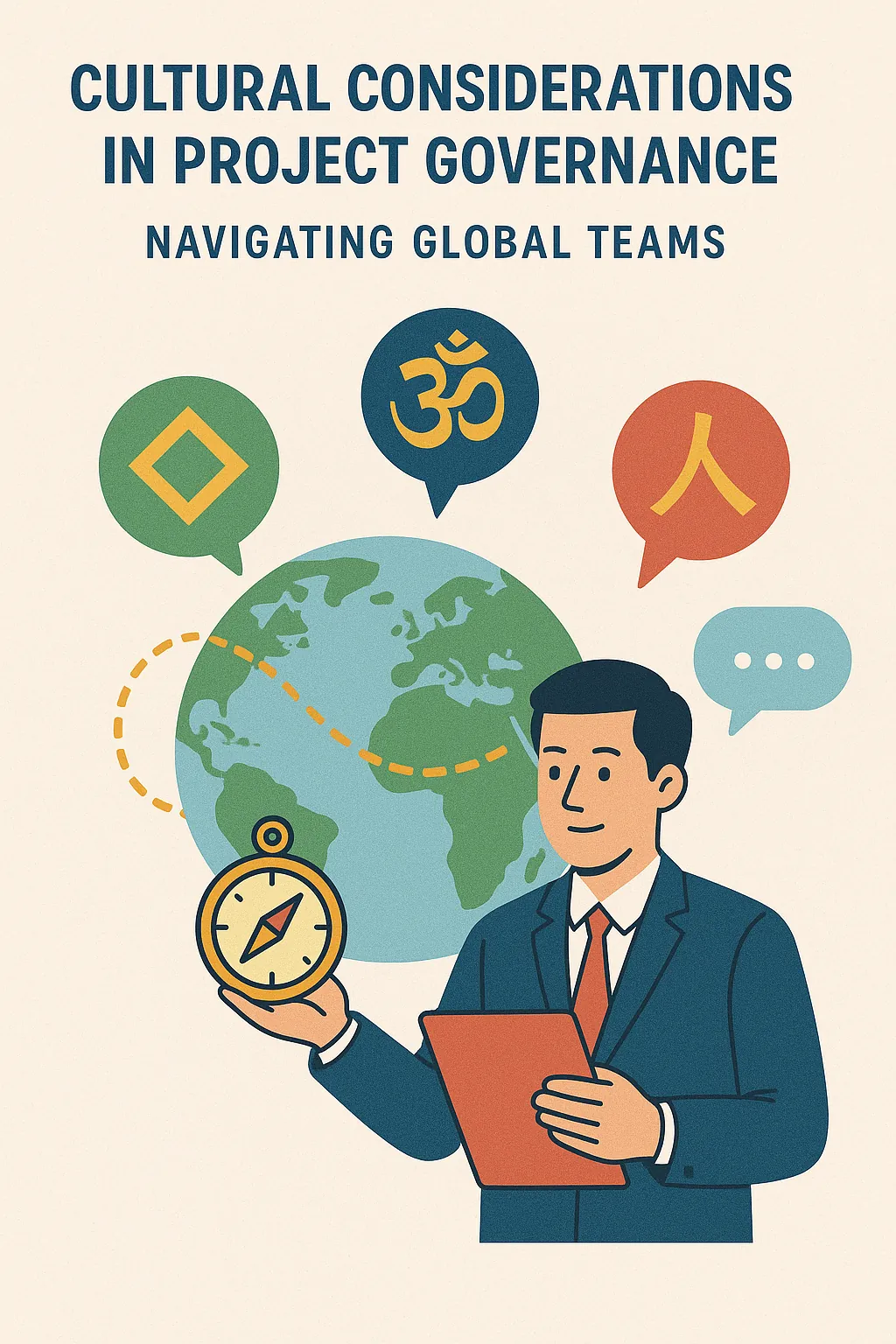Introduction
Project governance serves as a critical framework that guides decision-making, accountability, and stakeholder engagement throughout the project lifecycle. It encompasses the structures, processes, and policies that ensure projects are executed effectively and align with organizational objectives. By establishing clear roles and responsibilities, project governance helps mitigate risks, enhances transparency, and fosters collaboration among team members.
As organizations increasingly operate in a globalized environment, the prevalence of global teams has surged. Project managers now often find themselves leading diverse teams that span multiple countries and cultures. This shift presents unique challenges and opportunities, as team members bring varied perspectives, communication styles, and work ethics influenced by their cultural backgrounds. The ability to navigate these differences is essential for successful project execution and governance.
Cultural considerations play a pivotal role in shaping governance practices in international projects. Understanding how cultural norms and values influence decision-making processes, conflict resolution, and stakeholder engagement is crucial for project managers. For instance, in some cultures, a more hierarchical approach may be preferred, while others may favor a collaborative decision-making style. Recognizing these differences can help project managers tailor their governance strategies to foster inclusivity and enhance team dynamics. By prioritizing cultural awareness, project leaders can create an environment that not only respects diversity but also leverages it to drive project success.
Understanding Governance in Project Management
Governance serves as a critical framework that guides the decision-making processes, establishes accountability, and ensures effective control throughout the project lifecycle. As global project managers navigate diverse cultural landscapes, understanding the nuances of governance becomes essential for successful project execution. Here are the key components and considerations of project governance:
Key Components of Project Governance
- Decision-Making: Effective governance structures facilitate clear decision-making processes. This involves defining who has the authority to make decisions at various levels of the project. In international projects, cultural differences can influence decision-making styles; for instance, some cultures may favor consensus-driven approaches, while others may lean towards hierarchical decision-making. Understanding these preferences is crucial for fostering collaboration and ensuring that decisions are made efficiently and inclusively.
- Accountability: Accountability in project governance refers to the obligation of individuals and teams to report on their performance and the outcomes of their decisions. Establishing clear roles and responsibilities is vital, especially in global teams where cultural interpretations of accountability may vary. For example, in some cultures, accountability may be viewed as a collective responsibility, while in others, it may be more individualistic. Project managers must navigate these differences to create a culture of accountability that aligns with the team’s values and expectations.
- Control: Control mechanisms are essential for monitoring project progress and ensuring compliance with established standards and objectives. This includes setting up performance metrics, risk management strategies, and reporting systems. Cultural considerations play a significant role in how control is perceived and implemented. In cultures that prioritize flexibility and adaptability, rigid control measures may be met with resistance, while in more structured environments, detailed control processes may be expected. Project managers should tailor their control strategies to fit the cultural context of their teams.
Governance Frameworks and Their Applications
Various governance frameworks can be applied in project management, each with its own strengths and suitability depending on the project’s nature and cultural context. Some common frameworks include:
- PRINCE2 (Projects in Controlled Environments): This framework emphasizes a structured approach to project management, focusing on defined roles, responsibilities, and processes. It is particularly effective in environments where clarity and control are paramount.
- PMBOK (Project Management Body of Knowledge): PMBOK provides a comprehensive set of guidelines and best practices for project management. Its flexibility allows for adaptation to different cultural contexts, making it suitable for international projects.
- Agile Governance: In projects that require rapid adaptation and responsiveness, Agile governance frameworks promote iterative processes and stakeholder engagement. This approach can be particularly beneficial in cultures that value collaboration and innovation.
The Role of Stakeholders in Governance
Stakeholders play a pivotal role in project governance, influencing decisions, providing resources, and shaping project outcomes. In a global context, stakeholders may come from diverse cultural backgrounds, each bringing unique perspectives and expectations. Effective governance requires:
- Stakeholder Identification: Recognizing all relevant stakeholders, including clients, team members, suppliers, and regulatory bodies, is essential. Understanding their cultural backgrounds can help project managers anticipate their needs and concerns.
- Engagement Strategies: Developing tailored engagement strategies that respect cultural differences can enhance stakeholder involvement and commitment. This may involve adapting communication styles, meeting formats, and decision-making processes to align with stakeholders’ cultural preferences.
- Conflict Resolution: Cultural differences can lead to misunderstandings and conflicts among stakeholders. Establishing clear governance protocols for conflict resolution can help mitigate these issues and maintain project momentum.
The Impact of Culture on Governance Practices
In international settings, understanding cultural differences is crucial for effective governance. Cultural considerations can significantly influence governance structures, decision-making processes, and overall project success. This section delves into how cultural dimensions shape governance practices, drawing on established frameworks and real-world examples.
Defining Culture and Its Dimensions
Culture encompasses the shared values, beliefs, and behaviors of a group, influencing how individuals interact and make decisions. One of the most widely recognized frameworks for understanding cultural differences is Hofstede’s Cultural Dimensions Theory, which identifies several key dimensions that can impact governance:
- Power Distance: This dimension reflects the extent to which less powerful members of a society defer to more powerful ones. In high power distance cultures, such as many Asian countries, authority is respected, and decision-making is often centralized. Conversely, in low power distance cultures, like those in Scandinavia, a more egalitarian approach is favored, encouraging participation from all team members.
- Individualism vs. Collectivism: Individualistic cultures prioritize personal goals and autonomy, while collectivist cultures emphasize group harmony and consensus. This distinction can affect how teams approach governance, with individualistic cultures potentially favoring more direct accountability measures, whereas collectivist cultures may focus on group accountability.
- Uncertainty Avoidance: Cultures with high uncertainty avoidance prefer structured environments and clear rules, which can lead to more formal governance practices. In contrast, cultures with low uncertainty avoidance may be more adaptable and open to flexible governance structures.
Cultural Values and Attitudes Towards Authority and Accountability
Cultural values significantly shape attitudes towards authority and accountability within project governance. For instance:
- In cultures with a strong respect for hierarchy, such as Japan, decision-making may be slow and involve multiple levels of approval. This can lead to challenges in agile project environments where quick decisions are necessary. Project managers must navigate these hierarchical structures carefully to maintain momentum.
- Conversely, in cultures that value autonomy, such as the United States, team members may expect to take initiative and make decisions independently. This can foster innovation but may also lead to conflicts if not managed properly, as differing expectations around accountability can arise.
Communication Styles and Conflict Resolution
Cultural influences extend to communication styles and conflict resolution approaches, which are critical components of governance in international projects:
- Communication Styles: High-context cultures (e.g., many Asian and Middle Eastern cultures) rely heavily on non-verbal cues and the context of the conversation, often leading to indirect communication. In contrast, low-context cultures (e.g., the United States and Germany) favor direct and explicit communication. This difference can lead to misunderstandings in governance discussions, where clarity and transparency are essential.
- Conflict Resolution: Cultural backgrounds also influence how conflicts are addressed. In collectivist cultures, maintaining harmony is paramount, and conflicts may be resolved through mediation and consensus-building. In individualistic cultures, direct confrontation and assertiveness may be more acceptable. Project managers must be adept at recognizing these differences and adapting their conflict resolution strategies accordingly.
Strategies for Effective Governance in Diverse Teams
Particularly within international contexts, cultural differences can significantly influence governance practices. Understanding and navigating these differences is crucial for project managers aiming to lead diverse teams effectively. Here are actionable strategies to enhance governance in global projects:
1. Encourage Cultural Awareness and Sensitivity
- Training and Workshops: Implement regular training sessions focused on cultural awareness. These workshops can help team members understand the cultural backgrounds of their colleagues, fostering respect and reducing misunderstandings.
- Cultural Exchange Programs: Encourage team members to share their cultural practices and norms. This can be done through informal presentations or team-building activities that highlight different cultural perspectives.
- Diversity Champions: Appoint diversity champions within the team who can advocate for cultural sensitivity and serve as resources for team members seeking to understand different cultural viewpoints.
2. Establish Clear Communication Channels and Protocols
- Define Communication Norms: Establish clear guidelines on communication styles that respect cultural differences. For instance, some cultures may prefer direct communication, while others may value indirect approaches.
- Utilize Technology: Leverage communication tools that facilitate collaboration across time zones and languages. Tools like Slack, Microsoft Teams, or Zoom can help maintain open lines of communication.
- Regular Check-ins: Schedule regular meetings to ensure that all team members are on the same page. These check-ins can also serve as a platform for addressing any cultural misunderstandings that may arise.
3. Emphasize Inclusive Decision-Making Processes
- Diverse Representation: Ensure that decision-making bodies within the project include representatives from various cultural backgrounds. This diversity can lead to more innovative solutions and a broader understanding of project challenges.
- Consensus Building: Adopt decision-making processes that prioritize consensus. This approach respects different cultural perspectives and encourages collaboration, making team members feel valued and heard.
- Feedback Mechanisms: Implement anonymous feedback systems that allow team members to express their opinions on governance practices without fear of retribution. This can help identify areas for improvement and ensure that all voices are considered.
By integrating these strategies into project governance, global project managers can create an inclusive environment that respects cultural differences. This not only enhances team cohesion but also leads to more successful project outcomes, as diverse perspectives contribute to innovative solutions and effective problem-solving.
Tools and Resources for Cultural Governance
Particularly when dealing with international teams, understanding and navigating cultural differences is crucial for effective governance. Here are some essential tools and resources that can assist project managers in managing these cultural dynamics:
1. Cultural Assessment Tools and Frameworks
- Hofstede’s Cultural Dimensions Theory: This framework helps project managers understand how cultural values influence behavior in a business context. It includes dimensions such as Power Distance, Individualism vs. Collectivism, and Uncertainty Avoidance, which can provide insights into team dynamics and decision-making processes.
- Trompenaars’ Model of National Culture Differences: This model offers a comprehensive approach to understanding cultural differences through seven dimensions, including Universalism vs. Particularism and Individualism vs. Communitarianism. It can help project managers tailor their governance strategies to fit the cultural context of their teams.
- The GLOBE Study: This extensive research project identifies cultural dimensions and their impact on leadership and organizational practices across different countries. Utilizing the GLOBE framework can enhance a project manager’s ability to lead diverse teams effectively.
2. Training Programs and Workshops
- Cultural Competence Training: Many organizations offer workshops that focus on developing cultural awareness and sensitivity. These programs often include role-playing scenarios and case studies that help participants understand and appreciate cultural differences in a project setting.
- Cross-Cultural Communication Workshops: These workshops are designed to improve communication skills among team members from different cultural backgrounds. They often cover topics such as non-verbal communication, negotiation styles, and conflict resolution strategies.
- Online Courses on Cultural Intelligence: Platforms like Coursera and LinkedIn Learning provide courses that focus on building cultural intelligence (CQ). These courses equip project managers with the skills needed to navigate cultural complexities in global projects.
3. Resources for Ongoing Education
- Books and Publications: There are numerous books dedicated to cultural governance and project management. Titles such as “The Culture Map” by Erin Meyer and “Leading with Cultural Intelligence” by David Livermore offer valuable insights and practical strategies for managing cultural differences.
- Webinars and Conferences: Attending industry webinars and conferences focused on global project management can provide project managers with the latest trends and best practices in cultural governance. These events often feature expert speakers who share their experiences and insights.
- Professional Associations: Joining organizations such as the Project Management Institute (PMI) or the International Project Management Association (IPMA) can provide access to a wealth of resources, including research papers, case studies, and networking opportunities with other professionals in the field.
By leveraging these tools and resources, project managers can enhance their understanding of cultural differences and improve their governance practices in international projects. This proactive approach not only fosters a more inclusive team environment but also contributes to the overall success of global initiatives.
Conclusion
Particularly within international contexts, the importance of cultural considerations in governance cannot be overstated. As global project managers navigate diverse teams, it becomes essential to adapt governance practices to align with the cultural contexts of all stakeholders involved. This adaptability not only fosters a more inclusive environment but also enhances collaboration and communication, which are critical for project success.
Key insights from our exploration highlight that:
- Cultural Adaptation is Crucial: Governance frameworks that are rigid and fail to account for cultural nuances can lead to misunderstandings, conflicts, and ultimately project failure. By recognizing and integrating cultural differences into governance practices, project managers can create a more harmonious working environment that respects and values diverse perspectives.
- Prioritizing Cultural Awareness: Project managers should actively cultivate cultural awareness within their teams. This involves not only understanding the cultural backgrounds of team members but also being open to different communication styles, decision-making processes, and conflict resolution strategies. Such awareness can significantly improve team dynamics and project outcomes.
- Implementing Learned Strategies: We encourage readers to take the insights gained from this discussion and apply them in their own governance practices. Whether through training sessions, workshops, or informal discussions, fostering a culture of learning about cultural differences can lead to more effective governance and project execution.
Find out more about Shaun Stoltz https://www.shaunstoltz.com/about/.
This post was written by an AI and reviewed/edited by a human.



